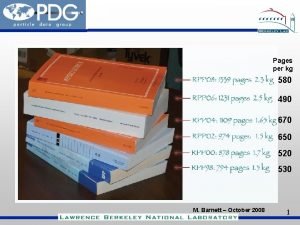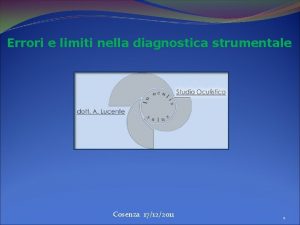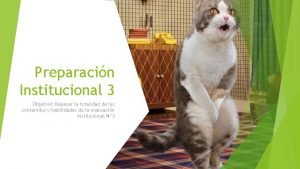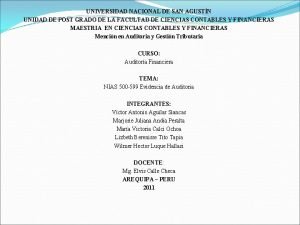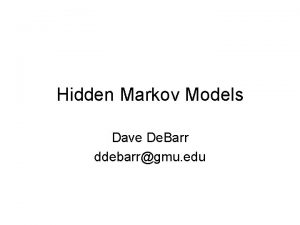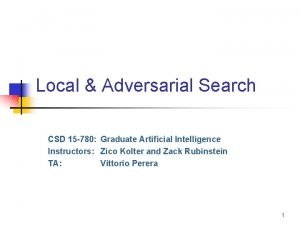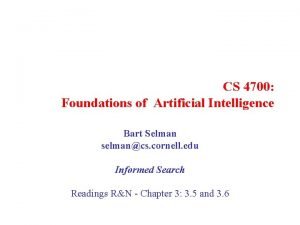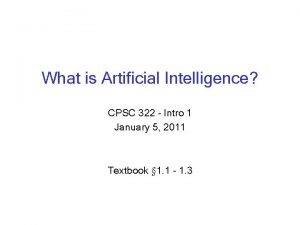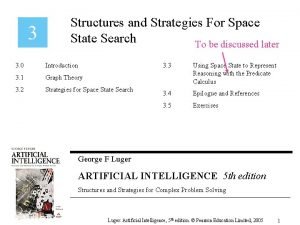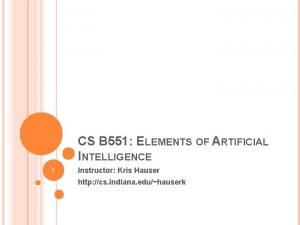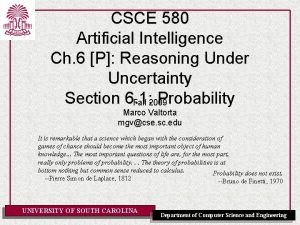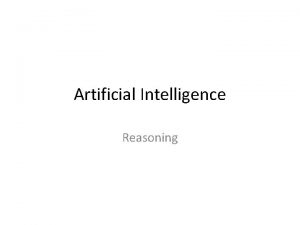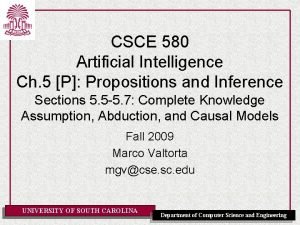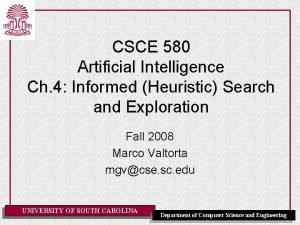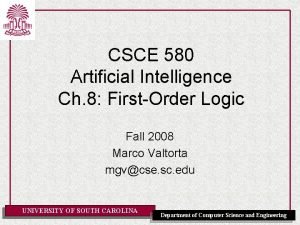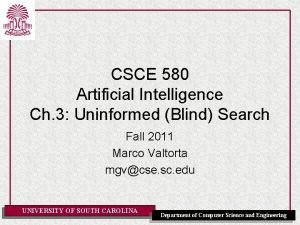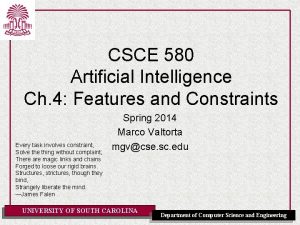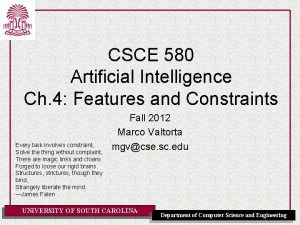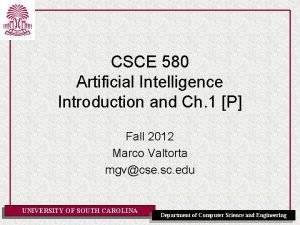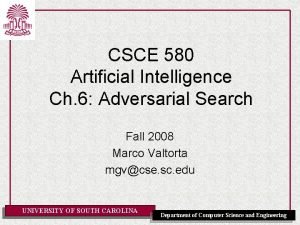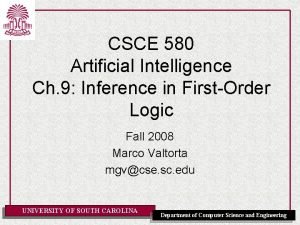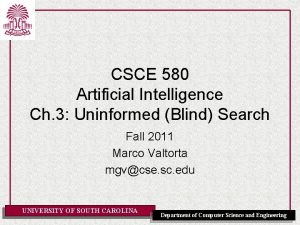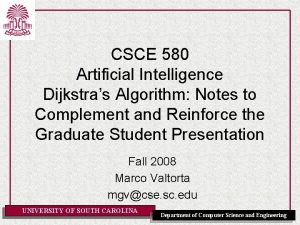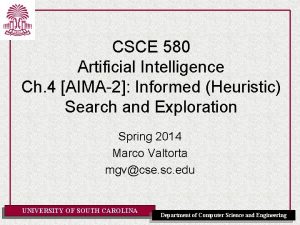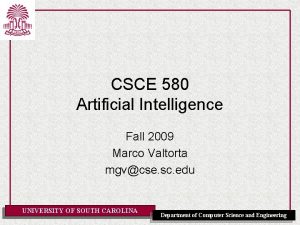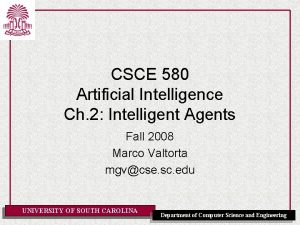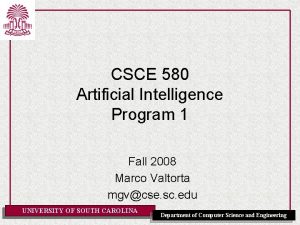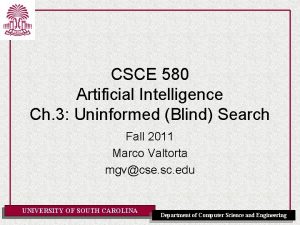CSCE 580 Artificial Intelligence Ch 6 P Reasoning
![CSCE 580 Artificial Intelligence Ch. 6 [P]: Reasoning Under Uncertainty Sections 6. 2 and CSCE 580 Artificial Intelligence Ch. 6 [P]: Reasoning Under Uncertainty Sections 6. 2 and](https://slidetodoc.com/presentation_image_h2/be17aa3b49cf56c9881e6ec97ded8f6d/image-1.jpg)
![Acknowledgment • The slides are based on the textbook [P] and other sources, including Acknowledgment • The slides are based on the textbook [P] and other sources, including](https://slidetodoc.com/presentation_image_h2/be17aa3b49cf56c9881e6ec97ded8f6d/image-2.jpg)




















- Slides: 22
![CSCE 580 Artificial Intelligence Ch 6 P Reasoning Under Uncertainty Sections 6 2 and CSCE 580 Artificial Intelligence Ch. 6 [P]: Reasoning Under Uncertainty Sections 6. 2 and](https://slidetodoc.com/presentation_image_h2/be17aa3b49cf56c9881e6ec97ded8f6d/image-1.jpg)
CSCE 580 Artificial Intelligence Ch. 6 [P]: Reasoning Under Uncertainty Sections 6. 2 and 6. 3: Independence and Belief (Bayesian) Fall 2009 Networks Marco Valtorta mgv@cse. sc. edu It is remarkable that a science which began with the consideration of games of chance should become the most important object of human knowledge. . . The most important questions of life are, for the most part, really only problems of probability. . . The theory of probabilities is at bottom nothing but common sense reduced to calculus. Probability does not exist. --Pierre Simon de Laplace, 1812 --Bruno de Finetti, 1970 UNIVERSITY OF SOUTH CAROLINA Department of Computer Science and Engineering
![Acknowledgment The slides are based on the textbook P and other sources including Acknowledgment • The slides are based on the textbook [P] and other sources, including](https://slidetodoc.com/presentation_image_h2/be17aa3b49cf56c9881e6ec97ded8f6d/image-2.jpg)
Acknowledgment • The slides are based on the textbook [P] and other sources, including other fine textbooks – [AIMA-2] – David Poole, Alan Mackworth, and Randy Goebel. Computational Intelligence: A Logical Approach. Oxford, 1998 • A second edition (by Poole and Mackworth) is under development. Dr. Poole allowed us to use a draft of it in this course – Ivan Bratko. Prolog Programming for Artificial Intelligence, Third Edition. Addison-Wesley, 2001 • The fourth edition is under development – George F. Luger. Artificial Intelligence: Structures and Strategies for Complex Problem Solving, Sixth Edition. Addison-Welsey, 2009 UNIVERSITY OF SOUTH CAROLINA Department of Computer Science and Engineering

Conditional Independence UNIVERSITY OF SOUTH CAROLINA Department of Computer Science and Engineering

Conditional Independence Is Symmetric UNIVERSITY OF SOUTH CAROLINA Department of Computer Science and Engineering

Example domain (diagnostic assistant) UNIVERSITY OF SOUTH CAROLINA Department of Computer Science and Engineering

Examples of conditional independence • The identity of the queen of Canada is independent of whether light l 1 is lit given whethere is outside power. • Whethere is someone in a room is independent of whether a light l 2 is lit given the position of switch s 3. • Whether light l 1 is lit is independent of the position of light switch s 2 given whethere is power in wire w 0. • Every other variable may be independent of whether light l 1 is lit given whethere is power in wire w 0 and the status of light l 1 (if it's ok, or if not, how it's broken). UNIVERSITY OF SOUTH CAROLINA Department of Computer Science and Engineering • Conditional independence is defined using numbers,

Idea of belief (Bayesian) networks UNIVERSITY OF SOUTH CAROLINA Department of Computer Science and Engineering

Bayesian networks • The method of strata for constructing a Bayesian network is given above • Usually, a Bayesian network is defined to also include probabilities, as in the following slide. UNIVERSITY OF SOUTH CAROLINA Department of Computer Science and Engineering

Components of a Bayesian network • A belief network consists of: – a directed acyclic graph with nodes labeled with random variables – a domain for each random variable – a set of conditional probability tables for each variable given its parents (including prior probabilities for nodes with no parents). UNIVERSITY OF SOUTH CAROLINA Department of Computer Science and Engineering

Example BN (6. 10) • Suppose we want to use the diagnostic assistant to diagnose whethere is a fire in a building based on noisy sensor information and possibly conflicting explanations of what could be going on. The agent receives a report about whether everyone is leaving the building. Suppose the report sensor is noisy: It sometimes reports leaving when there is no exodus, a false positive, and sometimes does not report when everyone is leaving, a false negative. Suppose the fire alarm going off can cause the leaving, but this is not deterministic relationship. Either tampering or fire could affect the alarm. Fire also causes smoke to rise from the building. UNIVERSITY OF SOUTH CAROLINA Department of Computer Science and Engineering

Example BN (6. 11) Let’s select an ordering where the causes of a variable are before the variable in the ordering. For example, the variable for whether a light is lit comes after variables for whether the light is working and whethere is power coming into the light. UNIVERSITY OF SOUTH CAROLINA Department of Computer Science and Engineering

Independence Assumptions in BNs UNIVERSITY OF SOUTH CAROLINA Department of Computer Science and Engineering

Example for D-Separation UNIVERSITY OF SOUTH CAROLINA Department of Computer Science and Engineering

D-separation: converging connections UNIVERSITY OF SOUTH CAROLINA Department of Computer Science and Engineering

D-Separation: Diverging Connections UNIVERSITY OF SOUTH CAROLINA Department of Computer Science and Engineering

D-Separation: Serial Connections UNIVERSITY OF SOUTH CAROLINA Department of Computer Science and Engineering

Using BNs: Diagnostic Assistant The power network can be used by the diagnostic assistant in a number of ways: • Conditioning on the status of the switches and circuit breakers, whethere is outside power and the position of the switches, you can simulate the lighting. • Given values for the switches, the outside power, and whether the lights are lit, you can determine the posterior probability that each switch or circuit breaker is ok or not. • Given some switch positions and some outputs and some intermediate values, you can determine the probability of any other variable in the network. UNIVERSITY OF SOUTH CAROLINA Department of Computer Science and Engineering

Updating Probabilities by Conditioning UNIVERSITY OF SOUTH CAROLINA Department of Computer Science and Engineering

Some features and properties of BNs • A belief network is automatically acyclic by construction. • A belief network is a directed acyclic graph (DAG) where nodes are random variables. • The parents of a node n are those variables on which n directly depends. • A belief network is a graphical representation of dependence and independence: – A variable is independent of its nondescendants given its parents. UNIVERSITY OF SOUTH CAROLINA Department of Computer Science and Engineering

Constructing BNs To represent a domain in a belief network, you need to consider: • What are the relevant variables? – What will you observe? – What would you like to find out (query)? – What other features make the model simpler? • What values should these variables take? • What is the relationship between them? This should be expressed in terms of local influence. • How does the value of each variable depend on its parents? This is expressed in terms of the conditional probabilities. UNIVERSITY OF SOUTH CAROLINA Department of Computer Science and Engineering

Example 5. 30 and 6. 14 The process of diagnosis is carried out by conditioning on the observed symptoms and deriving posterior probabilities of the faults or diseases. UNIVERSITY OF SOUTH CAROLINA Department of Computer Science and Engineering

Help System Example A Naïve Bayesian Classifier: P(H|F 1, F 2, …, Fn) = K x P(H) x P(F 1, F 2, …, Fn) = = K x P(H) x P(F 1|H) x P(F 2|H) x … x P(Fn | H) UNIVERSITY OF SOUTH CAROLINA Department of Computer Science and Engineering
 Nsa 580
Nsa 580 Nia 930
Nia 930 Pdg-670
Pdg-670 Isa 580 written representations summary
Isa 580 written representations summary Pachimetria 580
Pachimetria 580 Sterling elite 580
Sterling elite 580 El matematico griego pitagoras nacio en el año 580
El matematico griego pitagoras nacio en el año 580 Nia 530 ejemplos prácticos
Nia 530 ejemplos prácticos Berdasarkan gambar di samping, tentukan nilai sin 450!
Berdasarkan gambar di samping, tentukan nilai sin 450! Artificial intelligence: a modern approach
Artificial intelligence: a modern approach 15-780 graduate artificial intelligence
15-780 graduate artificial intelligence Roman yampolskiy
Roman yampolskiy Cs 188
Cs 188 Artificial intelligence
Artificial intelligence Rule based deduction system in artificial intelligence
Rule based deduction system in artificial intelligence Cpsc 322: introduction to artificial intelligence
Cpsc 322: introduction to artificial intelligence Artificial intelligence graph
Artificial intelligence graph Artificial intelligence chapter 1
Artificial intelligence chapter 1 15 780
15 780 Csci-b 551 elements of artificial intelligence
Csci-b 551 elements of artificial intelligence Coordinated plan on artificial intelligence
Coordinated plan on artificial intelligence Uas kecerdasan buatan
Uas kecerdasan buatan Conclusion of artificial intelligence
Conclusion of artificial intelligence


